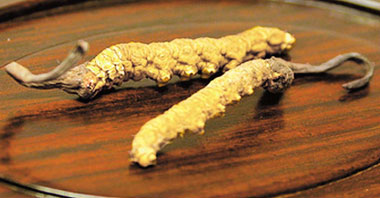|

|
|
Aweto looks like segmented caterpillars with rings, 16 feet and a long darker growth extending from the head.
|
Walk into any big TCM pharmacy and the first thing you see are strange tonics, weird objects - like dried up "worms" - extravagantly packaged on beds of colored satin, encased in fancy see-through boxes and locked behind glass cases.
Depending on their size, quality and arrangement in perfect shapes, they can cost tens of thousands of yuan, sometimes 9,000 yuan to 15,000 yuan (US$1,317-2,195) per 500 grams.
These are famous energy-reinforcing tonics for the weak, the elderly, for people who want to build their immune systems and cure just about anything ails them. Sore back and knees, cough, impotency? No problem, try a worm.
These tonics make very nice presents, especially if you want to impress someone and show off your wealth.
You can also buy tonics in smaller quantity or select them loose. These are much more affordable.
In coming weeks we will discuss a variety of famous, fundamental TCM herbs.
These include cordyceps ()(also called aweto, caterpillar fungus, Chinese caterpillar, or "summer worm, winter grass"); varieties of bird's nest (the nests of some swiftlets are made solely of saliva); dendrobe plant (orchid stems dried and wrapped in balls) and varieties of well-known ginseng root.
Cordyceps, a little dried yellow-brown worm, is famous in TCM and traditional Tibetan medicine and is exported worldwide. It is "neutral" in energy and reinforces both yin and yang energy.
It is commonly called aweto, dong chong xia cao (summer worm, winter grass) and caterpillar fungus. It's known in the West as a "medicinal mushroom."
This looks like segmented caterpillars with rings, 16 feet and a long darker growth extending from the head.
Aweto comes mainly from the Tibetan Plateau, Qinghai Province, western Sichuan Province, southwestern Gansu Province and northwestern Yunnan Province.
The creature is the result of a parasitic relationship between the fungus cordyceps and the larva of the ghost moth (thitarodes). The fungus germinates in the larva, kills and mummifies the insect host, and then the cordyceps grows from the head of the insect.
The larva is infected in winter and the fungus grows in summer, hence the name "summer worm, winter grass."
Sweet taste
The dried brittle larva is 3 to 5 centimeters long, up to 0.8 centimeter thick with a coarse yellowish-brown surface. The slender sporophore growing from the head is dark brown and longer than the larva, 2-8 centimeters long. It smells like an earthy, fishy mushroom. The taste is rather sweet.